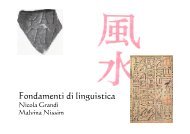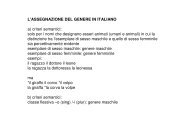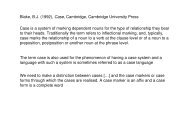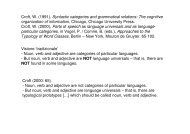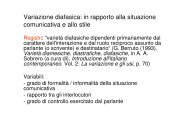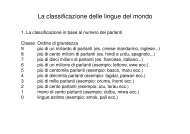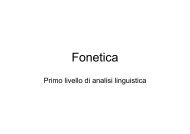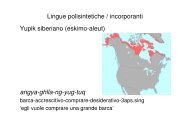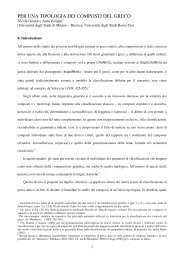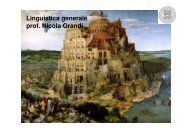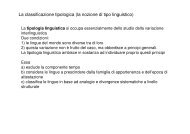Lingue senza aggettivi? - Grandionline.net
Lingue senza aggettivi? - Grandionline.net
Lingue senza aggettivi? - Grandionline.net
Create successful ePaper yourself
Turn your PDF publications into a flip-book with our unique Google optimized e-Paper software.
<strong>Lingue</strong> <strong>senza</strong> <strong>aggettivi</strong>?<br />
Mark Post (2008), Adjectives in Thai: Implications<br />
for a functionalist typology od word classes,<br />
Linguistic Typology, 12:3, 339-381<br />
<strong>Lingue</strong> del Sud Est asiatico: <strong>senza</strong> <strong>aggettivi</strong>?<br />
No, se si assume l’idea che le parti del discorso<br />
siano universalmente definite essenzialmente in<br />
base alla condivisione di funzioni pragmatiche
Adjective classes are nowadays routinely identified as prototypically<br />
containing words denoting property concepts (p. 341)<br />
concetti graduabili: <strong>aggettivi</strong><br />
concetti non graduabili: nomi e verbi<br />
Fundamentally, the semantic property of gradability would seem to lend<br />
adjectives an aptness for degree modification (more / less, a lot / little,<br />
the most / least), for lexicalization as points on a property scale (tiny,<br />
small, big, huge,…), as well as for comparison in terms of the relative<br />
degree of properties exhibited by two referents (p. 341)
Dixon, R. M. W. (1977), Where have all the adjectives gone?, “Studies in<br />
Language”, 1, 19–80<br />
Dixon, R. M. W. / Aikhenvald, A. Y. (eds.) (2004), Adjective Classes. A Cross-<br />
Linguistic Typology, Oxford, Oxford University Press<br />
CORE:<br />
Dimension (big, small…)<br />
Age (new, old…)<br />
Value (good, bad…)<br />
Colour (black, white…)<br />
PERIPHERY:<br />
Physical property (hard, soft…)<br />
Human propensity (happy, sad…)<br />
Speed (fast, slow…)<br />
Functionally, adjectives prototipically attribute features to a referent
Adjectives are often viewed as inherently mono-relational, in the semantic sense<br />
that their denotation may be viewed as incomplete without simultaneous construal<br />
of some entity or set which exhibits the stated property (e.g. a man who is tall), and<br />
in the syntactic sense that they either project (as predicate), cooccur with (as<br />
copula complement), or depend on (a modifier) one and only one referring<br />
expression.<br />
Thai<br />
Terms denoting properties are primarily divisible into<br />
-Verblike forms (the vast majority)<br />
- Nounlike forms
Verblike properties include terms from all of the core and peripheral semantis fields:<br />
dii ‘good’<br />
jεεÎ ‘bad’<br />
rO´On ‘hot’<br />
naÍaw ‘cold’<br />
Nounlike property concepts mainly correspond to the fields of PHYSICAL PROPERTY,<br />
HUMAN PROPENSITY, and COLOUR:<br />
thammachaÎat ‘natural(ness)’<br />
sùantua ‘private/privacy’<br />
saniÍm ‘rust(y)’
Proprietà distribuzionali<br />
Verblike property concepts occur as intransitive predicate and do not occur as<br />
copula complement<br />
Khon níi dəən<br />
CLF:person PRX walk<br />
‘This person walks’ (active verb, intransitive predicate)<br />
*Khon níi pen dəən<br />
CLF:person PRX ACOP walk<br />
‘This person walks’ (active verb, intransitive predicate)<br />
Khon níi dii<br />
CLF:person PRX good<br />
‘This person is good’ (verblike property term, intransitive predicate)<br />
*Khon níi pen dii<br />
CLF:person PRX ACOP good<br />
‘This person is good’ (verblike property term, intransitive predicate)<br />
PRX = proximate demonstrative<br />
ACOP = attributive copula
Nounlike property concepts behave more like concrete and abstract nouns in<br />
occurring as complement of an attributive copula<br />
Khan níi pen sanǐm<br />
CLF:VEHICLE PRX ACOP rust(y)<br />
‘This vehicle is rusty’ (nounlike property term, copula complement)<br />
*Khan níi sanǐm<br />
CLF:VEHICLE PRX rust(y)<br />
Khon níi pen phará?<br />
CLF:PERSON PRX ACOP monk<br />
‘This man is a monk’ (concrete noun, copula complement)<br />
*Khon níi phará?<br />
CLF:PERSON PRX monk
Verblike property terms take direct verbal predicate negation in mâj ‘NEG’ whereas<br />
nounlike property terms, like nouns, again usually require support of a copula or<br />
other predicative functor.<br />
Ma c’è una costruzione in cui possano occorrere solo i cosiddetti verblike property<br />
terms o i cosiddetti nounlike property terms? Solo in questo caso potremmo<br />
considerarli una classe autonoma…<br />
All and only verblike property terms may uncontroversially occupy the position<br />
provisionally marked “x” in the bare comparative of a discrepancy construction;<br />
stative and active verbs cannot usually occur in this position<br />
[NP1] [X] [COMP] [NP2]
Khon níi sǔuN kwàa khon nân<br />
[CLF:PERSON PRX] NP1 [tall] X [more] COMP [CLF:PERSON DST] NP2<br />
‘This person is taller than that person’ (verblike property term)<br />
*khon níi khít/dəən kwàa khon<br />
[CLF:PERSON PRX] NP1 [think/walk] X [more] COMP [CLF:PERSON<br />
nân<br />
DST] NP2<br />
‘This person thinks/walks more than that person (does)’ (stative/active verbs)<br />
DST = Distal demonstrative<br />
Such distributional differences [can be used] as evidence for<br />
the coalescence of a distinct class of lexemes whose semantic<br />
core is made up of property terms.
Khon níi sǔuN thâw khon nân<br />
[CLF:PERSON PRX] NP1 [tall] X equal [CLF:PERSON DST] NP2<br />
‘This person is tall as that person (is)’ (verblike property term)<br />
*khon níi khít thâw khon nân<br />
[CLF:PERSON PRX] NP1 [think] X equal [CLF:PERSON DST] NP2<br />
‘This person thinks/ as much as that person’ (stative/active verbs)<br />
DST = Distal demonstrative
Una parte del discorso non può essere chiusa: se esiste una classe di <strong>aggettivi</strong>,<br />
deve esistere anche il modo per formare nuovi <strong>aggettivi</strong>.<br />
nâa- “of an entity, have/be of a quality such that it seems like it would be nice to<br />
experience interaction with in terms of VERB”<br />
thanǒn sên nân nâa-dəən kwàa sên níi<br />
road CLF:LINE DST AZR-walk more CLF:LINE PRX<br />
‘That road looks more walkable (better or more suitable to walk on) than this one’<br />
châan- “having the characteristic of doing”<br />
khîi- “having the negative characteristic of doing”
“There is a class of terms in Thai which closely resembles the adjective classes of<br />
many other languages in terms of semantic contents, internal structure, and<br />
distribution relative to other lexical classes, and this class should therefore bear<br />
the label “adjective””<br />
Discovery of a linguistic universal “adjectives, properly defined, requires<br />
establishment of no single necessary and sufficient formal criterion such as<br />
“occurs as copula complement”; what it requires is the discovery that no language<br />
fails to develop grammatical means of treating property concept words differently<br />
from other types of terms. The typological-oriented prediction of Dixon (2004) that<br />
adjectives (so defined) will be found in every language can be falsified through<br />
discovery of a language in which property concept words are in fact NOT treated<br />
in any way differently from another well-defined type of term (say, verb or noun).
Strutture sintattiche e cervello: esistono lingue impossibili?
Area di Broca
“L’ipotesi più probabile è che i limiti delle sintassi delle lingue umane siano dovuti<br />
a una matrice di stampo biologico”<br />
(Andrea Moro (2006), I confini di Babele. Il cervello e il mistero delle lingue<br />
Impossibili, Milano, Bompiani, p. 146)<br />
Perché non ci sono mai (o quasi) errori sintattici?<br />
Perché un bambino può dire, anzi dice io ando o io piangio ma non dice mai casa la?<br />
Esiste una guida biologicamente determinata per l’apprendimento di una lingua,<br />
determinata dall’architettura funzionale del cervello?
1° esperimento: la autonomia della sintassi e il suo ‘posto’ nel cervello<br />
Una lingua immaginaria:<br />
- Hanno disbato le artine<br />
- Molte grapotte amionarono<br />
- Molti celuci furono taffivati<br />
- Nessun cribaso è stato incenghito<br />
…<br />
‘Errori’ fonologici:<br />
- Hanno dinsbato le artine<br />
- Molte grapotrte amionarono<br />
- Mosnti celuci furono taffivati<br />
- Nessun cribaso è stgtato incenghito<br />
…
‘Errori morfosintattici’<br />
- Hanno disbata le artine<br />
- Molti grapotti sono stata amionati<br />
- Molti celuci fu taffivati<br />
- Nessun cribaso siamo incenghito<br />
…<br />
‘Errori’ sintattici<br />
- Hanno disbate artine le con gli ziggoli<br />
- Grapotte molte amionarono<br />
- Celuce delle furono taffivate<br />
- Cribaso è incenghito nessuno a rimbaudo<br />
…<br />
“La nostra speranza […] era di vedere attivare zone diverse a seconda del tipo di<br />
errore e, in defintiva, di vedere per la sintassi una zona diversa dalle altre”<br />
(Andrea Moro (2006), I confini di Babele. Il cervello e il mistero delle lingue<br />
Impossibili, Milano, Bompiani, p. 185)
“Solamente nel caso dell’errore di tipo sintattico si attivano alcune zone sottocorticali<br />
dell’encefalo insieme alla componente profonda dell’area di Broca […].<br />
Questo è il punto centrale. Il riconoscimento dell’errore di tipo sintattico coinvolge una<br />
rete complessa che non si riscontra negli altri tipi di errori e tale rete non è<br />
rappresentata in un’unica area corticale ma si presenta come un insieme integrato di<br />
zone diverse”<br />
(Andrea Moro (2006), I confini di Babele. Il cervello e il mistero delle lingue<br />
Impossibili, Milano, Bompiani, p. 189)<br />
“Non solo dunque non esiste un’area singola per il linguaggio […], ma non esiste<br />
nemmeno un’area singola per la sintassi!”<br />
(Andrea Moro (2006), I confini di Babele. Il cervello e il mistero delle lingue<br />
Impossibili, Milano, Bompiani, p. 190)
2° esperimento: “far apprendere a dei soggetti adulti delle lingue straniere,<br />
«nascondendo», tra le regole delle grammatiche che i soggetti si apprestavano<br />
a imparare, delle regole che violano la grammatica universale, più specificamente<br />
delle regole che violano la dipendenza dalla struttura”<br />
(Andrea Moro (2006), I confini di Babele. Il cervello e il mistero delle lingue<br />
Impossibili, Milano, Bompiani, p. 195)<br />
(Andrea Moro (2006), I confini di Babele.<br />
Il cervello e il mistero delle lingue<br />
Impossibili, Milano, Bompiani, p. 203)
- Dipendenza dalla struttura<br />
Es. La ragazza di Pietro suona bene il pianoforte<br />
*Il Pietro pianoforte bene di ragazza suona la<br />
*Il pianoforte di Pietro suona bene la ragazza<br />
*il gatto si nascondono dietro l’albero<br />
I bambini che hanno inseguito il gatto si nascondono<br />
dietro l’albero
“Il fatto di rispettare o meno la dipendenza strutturale è dunque irrilevante per quanto<br />
riguarda l’accuratezza dell’apprendimento: sia che si trattasse si regole possibili, sia<br />
che si trattasse di regole impossibili, i soggetti arrivavano a una padronanza del tutto<br />
comparabile”<br />
(Andrea Moro (2006), I confini di Babele. Il cervello e il mistero delle lingue<br />
Impossibili, Milano, Bompiani, p. 205)<br />
Non ci sono lingue che non si possono imparare!<br />
Ma ci sono lingue che, naturalmente, non si sviluppano mai,<br />
anche se, appunto, saremmo in grado di apprenderle o usarle…
“Al crescere dell’accuratezza delle risposte sui giudizi di grammaticalità […]<br />
l’attività dell’area di Broca […] aumenta per le regole possibili mentre diminuisce<br />
per quelle impossibili. Il cervello ha, per così dire, «smistato» i dati sintattici (<strong>senza</strong><br />
che i soggettine avessero coscienza) e ha fatto elaborare solo le frasi che preservano<br />
la dipendenza dalla struttura dall’area normalmente predisposta per i compiti sintattici<br />
(l’area di Broca); nell’elaborazione di frasi che non rispettano la dipendenza dalla<br />
struttura, invece, l’attività nella stessa area diminuisce progressivamente”<br />
(Andrea Moro (2006), I confini di Babele. Il cervello e il mistero delle lingue<br />
Impossibili, Milano, Bompiani, p. 205)
Perceiving and naming actions and objects<br />
M. Liljeström, A. Tarkiainen, T. Parviainen, J. Kujala, J. Numminen, J. Hiltunen,<br />
M. Laine, and R. Salmelina<br />
NeuroImage 41 (2008) 1132–1141<br />
The existence of patients in whom focal brain damage is combined with<br />
selective impairments of grammatical categories has led to the suggestion that<br />
there are distinct cortical areas for processing verbs and nouns<br />
Lesion data has implied a link between left frontal areas and verb<br />
processing, whereas noun processing seems to depend on the integrity of<br />
left temporal areas
Nouns and verbs are distinguished in the brain on the basis of their semantic<br />
properties, nouns typically referring to objects and verbs to actions.<br />
In the present fMRI experiment, healthy subjects were asked to silently name<br />
actions and objects that were presented as simple line drawings. We used two<br />
sets of pictures, one depicting actions performed on/with objects and the other<br />
displaying only the objects. Subjects named both actions and objects from the<br />
action images, and objects from the object images. Actions were not named<br />
from pictures with isolated objects, as this task would require the subject to<br />
make inferences about the actions, a process not required in object naming. This<br />
design addresses the following questions:<br />
(i) Do action and object naming activate different cortical regions when the<br />
stimulus is identical?<br />
(ii) How does the content of the image (with/without action) modulate the brain<br />
correlates of object naming?
The task was to silently name actions or objects from simple line drawings.<br />
Two sets of images were used, each with 100 scenes. Action images illustrated<br />
a simple event (e.g. to write with a pen) whereas object-only images consisted<br />
of objects from the same images when the action had been dissolved into<br />
arbitrary lines in the background, in order to keep the visual complexity of<br />
the image unchanged.<br />
The corresponding object and action words were mostly of medium to high<br />
frequency in the Finnish language.<br />
The verb and noun corresponding to one image always had different word<br />
stems.
The experiment consisted of three conditions:<br />
(i) action naming from action images (Act),<br />
(ii) object naming from action images (ObjAct),<br />
(iii) object naming from object-only images (Obj).<br />
Task periods (30 s) and rest periods (21 s) alternated in a block design. There<br />
were two sessions, each lasting about 13 min.<br />
In order to avoid movement artifacts the participants were instructed to name the<br />
actions or objects silently. Subjects were asked to keep their eyes straight ahead<br />
during the rest condition and not to move during the experiment.<br />
Results: A similar <strong>net</strong>work of cortical areas was activated in all three conditions,<br />
including bilateral occipitotemporal and parietal regions, and left frontal cortex.
The occipitotemporal cortex and the fusiform gyrus were activated bilaterally in all<br />
conditions. When actions or objects were named from action images (Act and<br />
ObjAct) the activation additionally encompassed the left posterior middle<br />
temporal cortex. Activation was seen in the left inferior frontal gyrus in all tasks. In<br />
both action and object naming from action images (Act and ObjAct) the activation<br />
centered in the operculum of the inferior frontal gyrus and extended superiorly to<br />
include the precentral gyrus and anteriorly to BA 47. The frontal activation was<br />
less pronounced when objects were named from object-only images (Obj), mainly<br />
encompassing the inferior frontal region.
Naming objects from the images with action context compared to naming the same<br />
objects from object-only images (ObjActNObj, Fig. 3B) resulted in significantly<br />
stronger activation in a large mostly left-lateralized <strong>net</strong>work, including the precentral<br />
gyrus (BA 6/9), the inferior frontal gyrus (pars opercularis and triangularis), the<br />
inferior and superior parietal lobules (BA 7/40), and the posterior middle temporal<br />
gyrus. Naming actions compared to naming objects from object-only images<br />
(ActNObj, Fig. 3C) revealed enhanced activation in the left supramarginal gyrus<br />
(parieto-temporal junction; BA 40), left and right posterior middle temporal cortex,<br />
left precentral gyrus and superior medial frontal gyrus.<br />
Our results indicate that action and object naming engage a common cortical<br />
<strong>net</strong>work, but that the provided input (action pictures, object-only pictures) and the<br />
requested output (verb, noun) influence the level of activation in a subset of areas<br />
within that <strong>net</strong>work.<br />
The stronger activation in naming objects from pictures with action context,<br />
relative both to naming actions from the same images and to naming objects<br />
from object-only pictures, suggests involvement of additional task-specific<br />
processes.
We found no regions specific to nouns as a grammatical category. Our results<br />
agree with a recent study showing that when naming events either as verbs or<br />
nouns from identical images, no differences were found between verbs or nouns<br />
as grammatical categories.<br />
Our results converge with previous evidence showing that retrieval of verbs and<br />
nouns in the healthy human brain using identical stimuli in a picture naming task<br />
engages a similar distributed cortical <strong>net</strong>work, as measured with BOLD fMRI.<br />
Importantly, however, the content of the image (action vs. object only) had a<br />
pronounced effect on the activation in parts of that <strong>net</strong>work that have previously<br />
been implicated in processing of action knowledge. Furthermore, object naming in<br />
the context of action revealed additional activations, both in comparison to verb<br />
retrieval from the same set of images, and in comparison to noun retrieval from<br />
images not depicting action, suggesting that attention may be more directed<br />
towards motor-based properties of objects when they are presented not as single<br />
entities but as part of images that also depict the relevant action.



